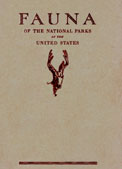![]()

Fauna Series No. 1
![]() Methods
Methods
Fauna of the National Parks
of the United States
CONSPECTUS OF WILD-LIFE PROBLEMS OF EACH PARK
MESA VERDE
The logical faunal unit for Mesa Verde National Park would include the whole of the mesa north and west of the Mancos River Canyon. In order to avoid the usual complications of an unprotected winter range, the south and east boundary should not stop with the Mancos River in the bottom of the canyon, but should follow the east and south cliffs of the canyon. Then the entire Mancos Canyon, as winter range, would be within the park. The north and west boundaries of the faunal unit, so outlined, would follow the base of the cliffs where the mesa terminates abruptly on the north and west.
Within this area it would be possible to preserve ail the existing forms of animal life which were of such great importance to the Cliff Dwellers a thousand years ago. This would give reality and color to the desert country as nothing else could.
The present park includes only a portion of the mesa north and west of the Mancos River. Animal life in the region is not now abundant, and it probably pays some toll to the Ute Indians. On the south and west sides of the park there are no present natural boundaries. It is like a house with two sides left open.
Considerable historical research will be necessary before the original (i. e., before white men came) status of animal life on the mesa can be determined. The fauna of the mesa is complex in that it is predominantly Great Basin, but is in close proximity to Rocky Mountain forms.
GRAY WOLF (Canis nubilus). – The gray wolves are probably gone permanently. They were in the mesa region formerly. "According to Mr. Steve Elkins, of Mancos, none have been reported in that region since the winter of 1904-5, when four or five were seen between Cortez and Mancos." 20
BLACK BEAR (Euarctos americanus). – Black bears may have been on the mesa in the past, although we know of none now. Merritt Cary reported that "an old female and cub were killed on Middle Mancos River, 10 miles east of Mancos." 21
PORCUPINE (Erethizon epixanthum). – See pages 61-63.
BROAD-TAILED BEAVER (Castor canadensis frondator). – Nordenskiöld22 reported beavers in the Mancos Canyon in 1891. Although they would never be abundant in these desert streams, they could still be maintained if sufficiently protected. If Mancos Canyon were included in the park, and the grazing of domestic sheep discontinued, there would be not only more beaver habitats but more forage for all forms of animal life which drift down the canyon in winter.
ROCKY MOUNTAIN MULE DEER (Odocoileus hemionus). – Deer are present, but not abundant, upon the mesa. They are wary and, consequently, not so commonly seen, although their tracks indicate their presence. Water is scarce, but there seems to be evidence that deer can and do go for weeks without it. Forage is abundant. It is thought that deer are taken by the Ute Indians whenever they can get them. However, aside from the question of providing suitable winter range for the deer, no other protective steps are necessary at present.
In 1927 four mule deer were shipped from Yosemite Valley to Mesa Verde. One of them died soon after shipment. Superintendent Finnan reports that the other three have had no fawns. The Yosemite deer are different from the Mesa Verde deer. It is to be hoped that no mixing of the forms will occur from this transplant.
ROCKY MOUNTAIN BIGHORN (Ovis canadensis canadensis). – Mountain sheep may have been on the mesa at sometime in the past. The question of reintroduction of sheep is quite analogous to the wild-turkey question discussed in relation to Mesa Verde on pages 26-27. If mountain sheep could exist on the mesa, they would be a most attractive feature of the park. This question, however, is raised for what it is worth. Since it is the tendency of mountain sheep to bed down in the shade of cliffs and to climb all over the cliffs, how much would this accelerate the destruction of unrestored cliff ruins?
GAME BIRDS. – Wild turkeys have been discussed on pages 26-27. Dusky grouse (Dendragopus obscurus obscurus) are present and seem to be holding their own. Scaled quail (Callipepla squamata) is the native quail of the region. Gambel quail, California quail, bobwhite, and pheasants have all been introduced into the regions surrounding the park. It is hoped that the scaled quail will maintain its range on the arid mesa, and that the exotics will not become established.
In general, the faunal picture at Mesa Verde is a favorable one. Just how much the vegetation and, consequently, animal life have been modified by the early years of cattle grazing and the adverse influences from outside the park is yet to be determined. With exception of the porcupine situation, there are no problems of conflict between animal life and human occupation. The chief difficulty at present lies in inadequate boundaries.
20 A Biological Survey of Colorado, by Cary, Merritt. North American Fauna No. 33, 1911, p. 196.
21 Ibid.
22 The Cliff Dwellers of the Mesa Verde, by Nordenskiöld, G., 1893, p. 5.
SOUTHWEST PARKS
Bryce Canyon | Carlsbad Caverns | Grand Canyon | Mesa Verde | Zion Canyon
PARKS
Southwest | Rocky Mountain | Pacific Coast | Eastern | Territorial
Top
Last Modified: Tues,
Feb 1 2000 07:08:48 pm PDT
http://www.cr.nps.gov/history/online_books/fauna1/fauna4a4.htm
![]()